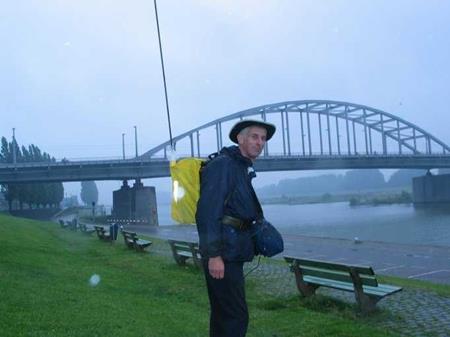IC-703s Assist Production of TV Documentary Film
Returning from a holiday Tom, G0SBW found an e-mail waiting for him which invited him to assist with a TV documentary on the battle of Arnhem. The TV program "Battlefield Detectives" scientifically examines the background and reasons for success and failure in major world battles. It is aired on the "History Channel" and "Discovery Channel". This September sees the 60th anniversary of the battle which was part of the biggest airborne operation that has ever been or is ever likely to be - Operation Market Garden. This involved the US 82nd and 101st Airborne Divisions, the British 1st Airborne Division and the Polish 1st Parachute Brigade. Had it been successful the Second World War would have been shortened considerably.
The battle of Arnhem involved the British and the Poles. They had the misfortune to drop into the middle of two heavily armoured, German, SS panzer divisions which were refitting in the area. The result was that the British and the Poles, despite a heroic fight, lost the battle and suffered more casualties than the Allies incurred during the whole of the D-Day landings. The full length feature film "A Bridge Too Far" tells the story of the battle.
One of the criticisms of the Arnhem battle is that the British did not have adequate radio communications. This was an aspect the programme wanted to investigate and it was this that Tom was asked to help with.
To be factually correct, the programme wanted to use comms equipment identical to that actually used in the battle to re-enact the actual communication routes. The purpose was to see how the equipment worked over the terrain and distances experienced during the battle and what part other factors such as training, or lack of it, played. Unfortunately there were no vintage radios available for use and it was thought that this part of the investigation would have to be shelved. Then the radio consultant to the programme (who is also a radio amateur) saw Tom's backpacking article in the June Radcom (magazine of The Radio Society of Great Britain).
The result was that Tom, together with Peter G8BLS, another pedestrian mobile enthusiast, went to the Arnhem battlefield in Holland during the second week of July. Their task was to simulate the actual comms situation during the battle. These "radio tests" form part of the television film. Simulating the wartime radios was challenging. The British radio set was the WS68P which generated 0.25W (yes, a quarter of a Watt) of AM fed into an 11ft whip. The frequency used was 2.2MHz! The tests used the top of the 160m amateur band.
One problem was how to resonate such a small whip on this band. Loading coils were made to ensure operation at this low frequency with such a small antenna bearing in mind there was no counterpoise or ground plane, just capacitive earth loading through the body.
Tom already owned a IC-703 and an FT817, Peter had an FT817 so they initially planned to use 817s for the test. However, during early coil/backpack testing the IC-703 proved to be far superior for this particular task. Because of its ease of producing accurate low power levels, built in SWR meter, autotuner and all round user friendliness they decided to use two IC-703s. Tom reports that his request to Icom UK for the loan of a IC-703 was met with commendable speed (just three working days from request to delivery).
The two IC-703s performed perfectly throughout the battlefield tests (including a three hour period of continuous rain). The second illustration shows Tom and Peter with their IC-703 driven backpacks standing at the side of a memorial to the people of Gelderland which is in the gardens of the Airborne Museum at Oosterbek.
Incredibly, a couple of days before the battlefield tests, a working WS68P was located just 20 minutes away from the battlefield site. This radio was used in the filming and the radio tests. Dutch amateurs Gerrit and Jan operated it exactly as shown in the painting.
The photo shows their two man pedestrian mobile operation. For comparison the final photograph shows Peter operating pedestrian mobile with his IC-703 based backpack at "The Bridge Too Far". Note the rain covers - this photo was taken at the end of a three hour session operating in the rain. The hows and whys of the building of the IC-703 backpacks and the nature of the radio tests they did at Arnhem will be the subject of an article in a future edition of Radcom.
The programme's conclusions regarding the failure of the comms which occurred during the actual battle will be revealed when the "Battlefield Detective" series is screened in 2005. The IC-703’s played an important part in providing some of the data on which these conclusions were reached. Tom and Peter regard them as the stars of their small part in the show.
Icom UK Marketing -
marketing@icomuk.co.uk
10/08/2004

